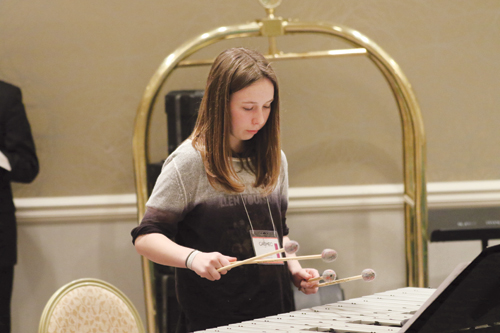
In both solo pieces and ensemble parts, percussionists frequently need four-mallet technique for the keyboard instruments. The following tips focus specifically on expanding students’ physical technique to play effectively with four mallets and assume that students have a solid grasp of two-mallet playing, including knowledge of the keyboard layout, correct basic technique, and the ability to read both treble and bass clefs. The following strategies can be used with any grip.
Isolate each of the four mallets first.
When approaching four-mallet technique students often think that they must begin playing with all four mallets immediately. Instead, they should hold all four but focus on just one mallet at a time, adapting what they already can play. For example, students can play repeated notes on one pitch, exercising dynamic and articulation control through changes in mallet height and stroke velocity. Encourage them to switch back and forth between holding one and two mallets per hand in the early stages of development, to compare their new technique to what they already know.
As students develop control with each of the four mallets on one pitch, they can begin playing scales, scalar patterns, and melodies. A great way to incorporate this into their regular practice is to have them hold four mallets every time they play scales and warmups with the ensemble. They can play these exercises with each of the four mallets in isolation and then with various combinations of two of the mallets in octaves.
Play one hand at a time.
The advantage to practicing each mallet individually first is that students simultaneously strengthen their hands and arms to play two mallets in each hand together. Students can now play one hand (two mallets) at a time, executing repeated static intervals, such as a perfect fifth or minor sixth. Students should practice these repeated intervals in various combinations of black and white keys, noting the need for adjustments in angle and grip to accommodate the keyboard layout. They should focus on maintaining flexibility in their fingers so that the mallets can move freely and play fully. The mallets should move and attack precisely and simultaneously, but they should not be held tightly within the hand. Again, periodic comparison to students’ original two-mallet technique should help. In both cases, mallets should move freely, with the hand providing only the minimum physical guidance necessary.
Once students can play isolated intervals repetitively, they should begin experimenting with changing intervals, still just one hand at a time. They can play a consistent pulse with one mallet repeating a pitch and the other ascending or descending the scale, gradually widening and closing the interval. During these shifts they should maintain fluid physical motion, steady tempo given the inconsistent size of changing intervals, and precision of playing spots, especially when shifting back and forth between black and white keys.
A natural extension of the previous exercise will be to continue playing scalar patterns, alternating the pairs of notes rather than playing them together. As the interval widens and closes, the hand must maintain the technical priorities just described, while also balancing the weight of one mallet against the other in motion. Students can also play scales in thirds and various arpeggio patterns to practice this stability and fluency.
Play both hands together.
As students become comfortable playing both mallets in each hand together and in alternation, they can combine both hands in similar exercises. They should begin by playing static block chords, with all four mallets striking exactly together. They should aim for the same goals as described for one hand only, but now supervising their technique across two hands and four mallets. Students should use their visual, aural, and kinesthetic senses to troubleshoot technical problems and monitor progress. A slight change in technique can be seen, heard, and felt if one is paying close attention, and any of these three modes can be the most effective in a given situation. As always, the mallets must be allowed to move freely within the hands. One can easily see in a mirror the physical tension created in the hands and arms if the mallets are controlled too tightly.
Once comfortable with playing repeated block chords, students can progress through changing intervals and alternating mallets in various combinations. At this stage students should learn to discriminate quickly whether a technical challenge that arises is truly a full four-mallet issue, or just a one-handed (two-mallet) issue. They should be prepared to revert back frequently to one-handed practice to isolate problem spots before returning to full four-mallet practice.
Additional tips.
Position the body in the middle of the range of notes you will play. Some foot shifting may be necessary, especially on a large marimba, but most of it can be eliminated with this bit of planning.
Develop a flexible roll speed, much like developing flexible vibrato on wind or string instruments. Percussionists should be able to sustain longer notes comfortably, with a single-stroke roll, and free from reliance on a predictable subdivision of the beat at the given tempo. The ear quickly tires of a roll that sounds like repetitive 16th or 32nd notes.
Remain physically flexible while playing, ready to reposition both large and small parts of the body quickly and more frequently than in two-mallet playing.
Practice four-mallet technique on numerous instruments. Playing close-knit chords with hard mallets on the orchestra bells is very different than widespread, resonant chords on a five-octave marimba. Students should become accustomed to playing four-mallet techniques with various mallets on many instruments.
Once you have developed the technique, use it. Four-mallet skill can be helpful when playing with multiple sticks and mallets in all sorts of busy situations. For example, a percussionist might hold two suspended cymbal mallets for a normal roll but add a triangle beater in one hand for the note that immediately follows it.
Four-mallet technique is a great asset to percussionists’ technical and musical abilities. Thoughtful, sequential development of strength, flexibility, and dexterity through individual, paired, and four-mallet practice opens opportunities to play modern ensemble parts and solo repertoire successfully.






